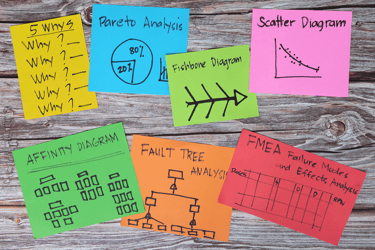The Packaging Industry's Sustainability Challenge: Why ERP Systems Are Essential for Success A straightforward guide to navigating sustainability regulations across folding carton, flexible...
Predictive Maintenance to Improve Corrugator Overall Equipment Efficiency (OEE)
In this article, we will delve into the importance of maintenance as a crucial approach to boost corrugator Overall Equipment Efficiency (OEE).
By understanding the significance of regular and preventive maintenance, you will learn how it can optimize production processes, reduce downtime, and minimize disruptions.
We will cover key techniques and best practices that can be implemented to identify potential issues before they escalate, leading to increased productivity and eliminating waste. This blog aims to provide valuable insights that will help you achieve higher levels of efficiency with improved OEE through effective maintenance strategies.
Contents
- What is Overall Equipment Efficiency (OEE)
- The problem of reactive maintenance as a strategy
- Preventative maintenance - a step in the right direction
- The lean approach - predictive maintenance
- How can ePS Packaging help?
What is Overall Equipment Efficiency (OEE)?
Overall Equipment Effectiveness (OEE) is a measure of manufacturing productivity that identifies losses, benchmarks progress, and improves the productivity of the manufacturing equipment, by reducing waste, for example.
An OEE score is given as a percentage that factors three metrics: availability, performance, and quality. A score of 100% means goods are being manufactured at 100% availability (no downtime), 100% performance (as fast as possible), and 100% quality (only good product).
Maintenance plays a pivotal role as a strategic approach to enhance corrugator Overall Equipment Efficiency (OEE). Companies can proactively address equipment downtime, reduce unplanned interruptions, and optimize production processes by implementing a robust maintenance strategy.
Embracing maintenance as a core element of the production process empowers businesses to achieve higher levels of efficiency, meet customer demands with greater precision, and gain a competitive edge in the corrugated packaging industry.
Let’s explore the options for a corrugator maintenance strategy.
The problem of reactive maintenance as a strategy
Historically, maintenance activities have required significant human resources to plan and execute while also being a sizable line item in the budget. This is why businesses are constantly seeking ways to improve the efficiency and cost of their maintenance activities.
Previously, corrugated manufacturers maintained their assets reactively by repairing or replacing an asset after it had failed. This reactive maintenance approach was problematic as it often required the equipment to break down, which stopped production and led to increased downtime and costly losses.
Preventative maintenance - a step in the right direction
Corrugated manufacturers transitioned to the preventive maintenance model to mitigate the inefficiencies of reactive maintenance. Preventive maintenance teams regularly schedule repair and service operations to prevent equipment failures by factoring in the expected lifetime of the assets to inspect and maintain them proactively to mitigate unexpected downtime and maintain manufacturing continuity.
Preventive maintenance is widely adopted as the approach for corrugated manufacturing; however, it has its challenges. With preventative maintenance, assets are scheduled for maintenance before their End of Life (EoL), meaning that Overall Equipment Efficiency (OEE) is sub-optimal. To achieve optimal OEE, corrugated manufacturers should plan maintenance activities based on information about the status of the assets instead of hypothetical EoL values.
The lean approach - predictive maintenance
This is where predictive maintenance comes in. Predictive maintenance means businesses can schedule maintenance activities based on accurate predictions about an asset’s lifetime.
Predictive maintenance is a strategy that uses data analysis tools and techniques to monitor equipment performance and predict when maintenance should be performed. This approach can help improve Overall Equipment Efficiency (OEE) by addressing potential issues before they become critical problems.
Predictive maintenance helps improve corrugator OEE and productivity by identifying potential issues before they cause downtime or other problems, reducing maintenance costs, increasing equipment longevity, and enhancing product quality.
Predictive maintenance offers many business benefits when compared to the conventional reactive and preventive models:
- Improved asset utilization and OEE: Manufacturers make the best possible use of their assets and improve their OEE by adopting a predictive maintenance strategy.
- Avoid unscheduled downtime: Predictive maintenance provides data on the actual condition of the assets, minimizing possible unscheduled downtime.
- Optimal planning of maintenance activities: Information about the asset’s conditions and anticipated EoL can be combined with insights on business operations (e.g., production schedules, demand forecasts, etc.) towards maximizing revenues and minimizing Maintenance, Repair, and Operations (MRO) costs.
The benefits of predictive maintenance translate into significant cost savings and increased revenue for corrugated manufacturers who choose to adopt this approach.
How can ePS Packaging help?
The Escada team at eProductivity Software (ePS) has more than 35 years of experience in corrugator control technology. As corrugated businesses have adopted lean initiatives and moved towards a digitized Industry 4.0 operation, they look to Escada to provide software and hardware solutions to improve processes continuously.
Escada’s Reliability module is a predictive maintenance module that alerts operators when assets are due to renew or require service attention.
The Reliability module works with Escada’s Syncro and Next Gen Clarity solutions to monitor the real-time usage of equipment on the corrugator and alerts operators when equipment requires attention, alerting production operators of issues, helping them control maintenance schedules, and avoiding costly downtime.
At a glance, you can see which assets require maintenance, whether servicing or renewal, and schedule when the correct maintenance needs to happen. The Reliability module helps to improve Overall Equipment Effectiveness (OEE) and limit unplanned production downtime.
Reliability can be used as a standalone maintenance tool for a corrugator or used to complement an existing CMMS system enhancing the quality of the result with real-time data.
Escada Reliability is just one way we help you continuously improve your lean industry 4.0 initiatives.




